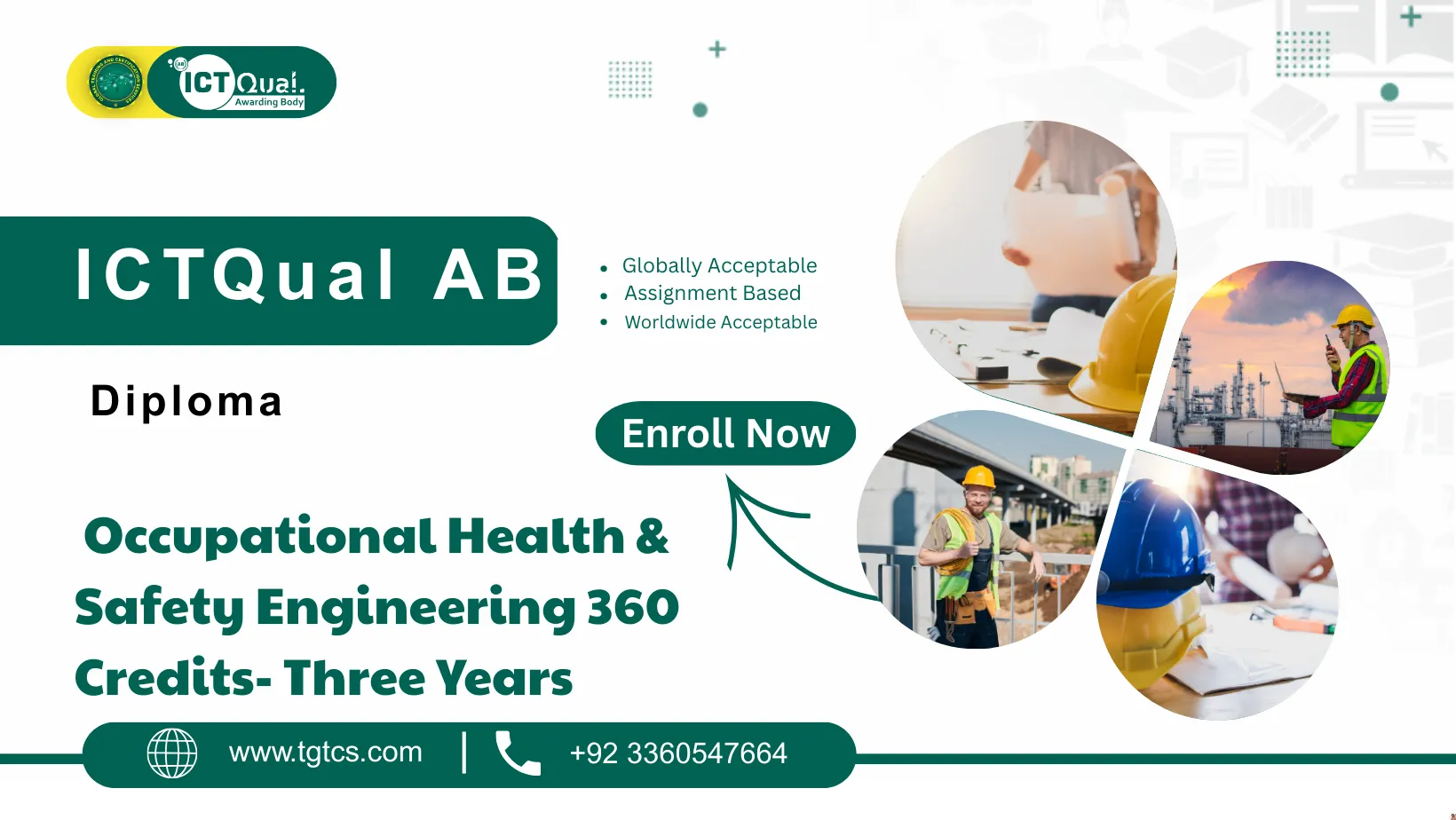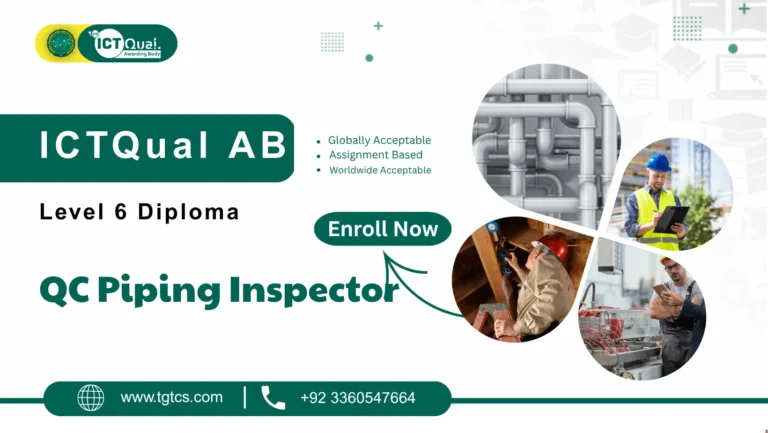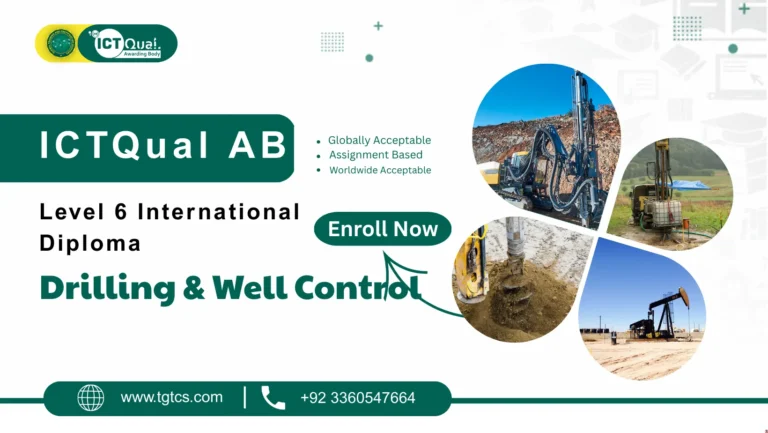ICTQual AB Diploma in Occupational Health and Safety Engineering 360 Credits- Three Years
The ICTQual AB Diploma in Occupational Health and Safety Engineering 360 Credits- Three Years is meticulously designed to address this need, offering a comprehensive three-year program that imparts essential knowledge and practical skills to manage workplace risks effectively.
This diploma program encompasses a broad spectrum of topics, including risk assessment, safety management systems, hazard identification, and compliance with international safety standards. Learners will engage with both theoretical concepts and hands-on applications, preparing them to implement robust safety protocols across various industries.
Graduates of this program will acquire the expertise to conduct thorough safety audits, develop and enforce safety policies, and lead initiatives that foster a culture of safety within organizations. The curriculum is structured to provide a deep understanding of occupational health and safety engineering principles, ensuring that learners are well-equipped to tackle the challenges of modern workplaces.
Upon successful completion, learners will be positioned to pursue advanced roles in occupational health and safety, with opportunities for further academic progression and professional development. This qualification not only enhances employability but also contributes to the creation of safer work environments globally.
The Global Training and Certification Services is Approved Training Centre of ICTQual AB UK Ltd
Course Level and Credits
The ICTQual AB Diploma in Occupational Health and Safety Engineering is a Level 6 International Diploma, carrying 360 credits, designed to provide comprehensive knowledge and practical expertise for learners at all stages of their careers. This qualification is ideal for fresh students who wish to build a strong foundation in occupational health and safety engineering as well as for experienced professionals seeking to enhance their skills, gain international recognition, and advance their careers in safety-critical industries. The program equips learners with the knowledge to assess, manage, and improve workplace safety systems effectively while ensuring compliance with global safety standards.
Mode of Study
This diploma is fully assignment-based, allowing learners to study at their own pace and from anywhere in the world, making it exceptionally flexible for working professionals, international learners, and those balancing personal or professional commitments. Fresh students are expected to complete 36 mandatory assignments over three years, gaining a thorough understanding of workplace safety, hazard identification, risk assessment, and safety management systems. Experienced professionals with at least six years of verifiable relevant experience can fast-track the certification by demonstrating their expertise through professional discussion meetings with an ICTQual AB approved assessor, bypassing the need to complete all mandatory assignments. This ensures recognition of prior experience and offers a highly efficient route to achieving the qualification.
Global Recognition & Attestation
The diploma is British Council verifiable and MOFA and Embassy attested, providing international credibility and recognition. It is highly suitable for career advancement, employment, and iqama approval in Gulf countries, offering learners a prestigious qualification that is acknowledged by employers and professional bodies worldwide. This global recognition makes the diploma a valuable asset for those seeking roles in multinational organizations or aiming to establish themselves in highly regulated industries where occupational health and safety expertise is essential.
Scope and Purpose
The program covers a wide range of topics critical to occupational health and safety engineering, including workplace safety protocols, risk assessment, hazard identification, compliance with international safety standards, and the implementation of safety management systems. The course balances theoretical knowledge with practical application, enabling learners to create safer work environments across various industries. From conducting thorough safety audits to developing and enforcing safety policies, the diploma prepares learners to address complex safety challenges effectively while fostering a culture of health and safety within organizations.
Skills and Knowledge Gained
Learners will gain practical skills in conducting safety audits, implementing and monitoring safety policies, managing workplace risks, and ensuring full compliance with international regulations. In addition, they will enhance critical analytical, leadership, and strategic decision-making abilities, enabling them to manage teams, advise on safety strategies, and contribute to long-term organizational safety goals. The diploma ensures that graduates are competent not only in technical safety operations but also in guiding organizational practices that reduce risks and improve employee well-being.
Career Benefits
Graduates of this diploma can pursue advanced roles in occupational health and safety across industries such as oil and gas, construction, manufacturing, healthcare, and other sectors where safety is paramount. The qualification enhances employability, professional credibility, and eligibility for international employment and iqama approval. By combining technical mastery, practical experience, and globally recognized certification, the ICTQual AB Diploma in Occupational Health and Safety Engineering empowers learners to achieve career growth, contribute to safer workplaces, and secure prestigious roles in organizations worldwide.
Mandatory Unit
This qualification, the ICTQual AB Diploma in Occupational Health and Safety Engineering 360 Credits- Three Years, consists of 36 mandatory units.
Year 1 – Foundation Level
- Introduction to Occupational Health and Safety
- Principles of Risk Assessment and Management
- Workplace Safety Legislation and Compliance
- Fundamentals of Fire Safety Management
- Personal Protective Equipment (PPE) in the Workplace
- Environmental Health and Safety Awareness
- Accident Investigation and Reporting Procedures
- Ergonomics and Human Factors in Safety
- Health and Safety Communication Skills
- Hazard Identification and Control Measures
- Basics of Industrial Hygiene
- Introduction to Emergency Preparedness and Response
Year 2 – Intermediate Level
- Advanced Risk Assessment Techniques
- Fire Safety Systems and Evacuation Planning
- Safety Management Systems (ISO 45001)
- Workplace Safety Auditing and Inspection
- Electrical Safety in the Workplace
- Mechanical and Machinery Safety
- Environmental Protection and Sustainability Practices
- Occupational Health Monitoring and Surveillance
- Safety Leadership and Team Management
- Hazardous Materials and Chemical Safety
- Noise, Vibration, and Occupational Stress Management
- Construction and Industrial Safety Practices
Year 3 – Advanced Level
- Strategic Health and Safety Management
- Advanced Fire Risk Management and Prevention
- Safety Culture Development and Behavioural Safety
- Advanced Accident Investigation and Root Cause Analysis
- Ergonomic Risk Management in Industrial Settings
- Emergency Planning and Crisis Management
- Safety Performance Metrics and KPI Analysis
- Legal Compliance and Occupational Safety Standards
- Environmental Health and Safety Policy Development
- Health and Safety Project Planning and Implementation
- Leadership in Occupational Safety Engineering
- Capstone Project in Occupational Health and Safety Engineering
The ICTQual AB Diploma in Occupational Health and Safety Engineering (360 Credits – Three Years) equips learners with comprehensive knowledge, practical skills, and professional expertise required to excel in occupational health and safety roles across global industries. This qualification is designed to provide a structured pathway for fresh students to gain foundational knowledge and for experienced professionals to fast-track certification by demonstrating prior experience.
Year 1 – Foundation Level
Introduction to Occupational Health and Safety
- Understand core principles and objectives of occupational health and safety.
- Identify workplace hazards and basic preventive measures.
- Develop awareness of the role of health and safety in organizational performance.
- Apply basic safety procedures to maintain a secure work environment.
Principles of Risk Assessment and Management
- Conduct basic risk assessments using standardized frameworks.
- Identify, evaluate, and prioritize workplace risks.
- Implement control measures to minimize hazards.
- Understand the hierarchy of risk control strategies.
Workplace Safety Legislation and Compliance
- Gain knowledge of national and international health and safety laws.
- Apply compliance requirements in real-world workplace scenarios.
- Understand employer and employee responsibilities under legislation.
- Develop documentation for legal and regulatory compliance.
Fundamentals of Fire Safety Management
- Identify fire hazards and understand fire behavior.
- Learn fire prevention techniques and safety protocols.
- Understand fire detection and suppression systems.
- Develop basic fire emergency response plans.
Personal Protective Equipment (PPE) in the Workplace
- Understand types and selection of PPE for different hazards.
- Learn proper usage, maintenance, and storage of PPE.
- Assess PPE effectiveness in workplace safety scenarios.
- Develop PPE compliance procedures for employees.
Environmental Health and Safety Awareness
- Understand the impact of workplace activities on the environment.
- Learn strategies to minimize environmental hazards.
- Implement eco-friendly safety practices and sustainability measures.
- Promote awareness of environmental regulations in the workplace.
Accident Investigation and Reporting Procedures
- Identify causes and contributing factors of workplace accidents.
- Learn techniques for incident investigation and data collection.
- Prepare accurate accident reports and documentation.
- Recommend corrective actions to prevent recurrence.
Ergonomics and Human Factors in Safety
- Understand ergonomic principles and their impact on workplace safety.
- Identify musculoskeletal risks and prevention methods.
- Apply human factor analysis to improve safety performance.
- Promote ergonomic interventions in industrial and office environments.
Health and Safety Communication Skills
- Develop effective safety communication strategies.
- Learn to convey health and safety policies clearly to employees.
- Conduct safety briefings and training sessions.
- Foster a culture of open communication around workplace safety.
Hazard Identification and Control Measures
- Identify physical, chemical, biological, and psychosocial hazards.
- Apply appropriate control measures to reduce risk.
- Implement hazard tracking and monitoring systems.
- Evaluate the effectiveness of safety interventions.
Basics of Industrial Hygiene
- Understand occupational exposure limits and standards.
- Learn techniques for monitoring workplace hazards.
- Implement hygiene practices to reduce employee exposure.
- Promote health protection strategies in industrial environments.
Introduction to Emergency Preparedness and Response
- Develop emergency response plans for different scenarios.
- Learn evacuation procedures and crisis management basics.
- Conduct drills and readiness assessments.
- Coordinate emergency communication and resource management.
Year 2 – Intermediate Level
Advanced Risk Assessment Techniques
- Apply quantitative and qualitative risk assessment methods.
- Analyze complex workplace hazards and control options.
- Develop comprehensive risk management plans.
- Evaluate effectiveness of implemented controls.
Fire Safety Systems and Evacuation Planning
- Understand advanced fire detection and suppression systems.
- Develop and implement workplace evacuation strategies.
- Conduct fire risk assessments and emergency simulations.
- Ensure compliance with fire safety regulations.
Safety Management Systems (ISO 45001)
- Implement and maintain ISO 45001-compliant safety systems.
- Conduct internal audits and continuous improvement activities.
- Develop documentation for safety policies and procedures.
- Align safety practices with organizational objectives.
Workplace Safety Auditing and Inspection
- Conduct detailed safety inspections and workplace audits.
- Identify non-compliance and recommend corrective actions.
- Prepare audit reports for management and regulatory bodies.
- Monitor the effectiveness of implemented safety interventions.
Electrical Safety in the Workplace
- Identify electrical hazards and risk factors.
- Implement safe work practices for electrical operations.
- Apply lockout/tagout procedures and emergency response measures.
- Promote electrical safety awareness among employees.
Mechanical and Machinery Safety
- Understand safe operation of machinery and equipment.
- Implement guarding, maintenance, and safety protocols.
- Conduct risk assessments specific to mechanical hazards.
- Develop training programs for machinery operators.
Environmental Protection and Sustainability Practices
- Implement workplace strategies to reduce environmental impact.
- Promote sustainable health and safety practices.
- Monitor environmental compliance and reporting.
- Integrate environmental awareness into organizational safety culture.
Occupational Health Monitoring and Surveillance
- Conduct health monitoring programs for employees.
- Identify occupational illnesses and work-related conditions.
- Implement early intervention strategies.
- Analyze health data to improve workplace safety programs.
Safety Leadership and Team Management
- Develop leadership skills for managing health and safety teams.
- Foster a proactive safety culture within organizations.
- Motivate and mentor staff in safety compliance.
- Coordinate safety initiatives across departments.
Hazardous Materials and Chemical Safety
- Identify and classify hazardous substances.
- Implement safe handling, storage, and disposal procedures.
- Understand chemical risk assessments and exposure control.
- Develop emergency response plans for chemical incidents.
Noise, Vibration, and Occupational Stress Management
- Assess workplace noise and vibration hazards.
- Implement mitigation measures to reduce exposure.
- Identify and manage occupational stress factors.
- Promote overall employee well-being and health.
Construction and Industrial Safety Practices
- Apply safety principles in construction and industrial environments.
- Identify hazards specific to construction sites and heavy industry.
- Develop safety plans for projects and operations.
- Ensure compliance with industry-specific regulations.
Year 3 – Advanced Level
Strategic Health and Safety Management
- Develop organizational strategies for health and safety.
- Integrate safety planning into corporate objectives.
- Evaluate long-term safety performance and outcomes.
- Lead strategic initiatives to improve workplace safety culture.
Advanced Fire Risk Management and Prevention
- Conduct detailed fire risk assessments in complex environments.
- Implement advanced fire prevention techniques.
- Plan and simulate emergency fire scenarios.
- Ensure organizational compliance with fire safety legislation.
Safety Culture Development and Behavioural Safety
- Promote behavioral safety practices across the workforce.
- Analyze factors influencing safety culture and employee behavior.
- Implement programs to enhance proactive safety engagement.
- Measure effectiveness of safety culture initiatives.
Advanced Accident Investigation and Root Cause Analysis
- Conduct thorough investigations of complex incidents.
- Apply root cause analysis to prevent recurrence.
- Prepare comprehensive investigation reports.
- Recommend corrective and preventive measures.
Ergonomic Risk Management in Industrial Settings
- Assess ergonomic risks in industrial environments.
- Design interventions to improve worker safety and comfort.
- Monitor effectiveness of ergonomic programs.
- Reduce musculoskeletal injuries and improve productivity.
Emergency Planning and Crisis Management
- Develop advanced emergency response plans.
- Coordinate crisis management teams and procedures.
- Conduct simulations and readiness assessments.
- Ensure resilience and continuity during emergencies.
Safety Performance Metrics and KPI Analysis
- Define key performance indicators for health and safety.
- Analyze safety performance data to guide improvements.
- Benchmark against industry standards.
- Report findings to senior management and stakeholders.
Legal Compliance and Occupational Safety Standards
- Ensure compliance with national and international safety legislation.
- Understand regulatory frameworks across different industries.
- Implement compliance monitoring systems.
- Advise organizations on legal safety obligations.
Environmental Health and Safety Policy Development
- Develop comprehensive EHS policies and procedures.
- Integrate sustainability and safety goals into organizational policies.
- Communicate policies effectively to employees and stakeholders.
- Review and update policies for continuous improvement.
Health and Safety Project Planning and Implementation
- Plan and manage health and safety projects from initiation to completion.
- Coordinate resources, budgets, and timelines effectively.
- Apply project management techniques to safety initiatives.
- Evaluate project outcomes and impact on workplace safety.
Leadership in Occupational Safety Engineering
- Develop advanced leadership and management skills in health and safety.
- Mentor teams and promote a culture of continuous improvement.
- Lead organizational change initiatives focused on safety.
- Influence strategic decisions to prioritize safety outcomes.
Capstone Project in Occupational Health and Safety Engineering
- Conduct a comprehensive, real-world occupational health and safety project.
- Apply theoretical knowledge and practical skills gained throughout the course.
- Analyze complex workplace safety challenges and develop solutions.
- Present findings and recommendations to a panel of assessors.
The ICTQual AB Diploma in Occupational Health and Safety Engineering (360 Credits – Three Years) empowers learners with advanced knowledge, practical skills, and strategic expertise to excel in workplace safety, risk management, and occupational health leadership across global industries.
Career Advancement Opportunities
- Opens pathways to roles in oil and gas, construction, manufacturing, healthcare, and other safety-critical sectors.
- Enhances professional credibility and recognition for leadership positions in safety management, compliance, and consultancy roles.
Global Competence and Strategic Skills
- Develop advanced skills in risk assessment, safety management systems, fire and emergency planning, and regulatory compliance.
- Gain expertise in occupational health, environmental protection, and sustainable workplace practices aligned with international standards.
Practical Knowledge and Analytical Expertise
- Learn to apply theoretical safety knowledge to real-world industrial, commercial, and organizational scenarios.
- Develop analytical, problem-solving, and data-driven skills for safety audits, accident investigation, and hazard control.
Networking and Professional Growth
- Build professional connections with global peers, safety experts, and industry leaders.
- Enhance employability and recognition for international roles, iqama approval, and globally accredited safety positions.
Leadership and Ethical Competence
- Strengthen leadership abilities for managing teams, projects, and organizational safety initiatives.
- Develop a strong understanding of ethics, compliance, and social responsibility in occupational health and safety engineering.
By completing this diploma, learners gain a comprehensive understanding of occupational health and safety, positioning themselves as skilled, strategic, and globally recognized professionals ready to lead and influence workplace safety standards across industries.
The ICTQual AB Diploma in Occupational Health and Safety Engineering is designed for learners from diverse backgrounds who aspire to excel in occupational health, safety management, and risk assessment across global industries.
Fresh Graduates
- Individuals who have recently completed studies in engineering, health, or safety-related disciplines seeking a strong foundation in occupational health and safety.
- Learners aiming to gain practical skills and globally recognized certification to enhance employability in safety-critical industries.
Industry Professionals
- Safety officers, supervisors, and managers looking to deepen their technical knowledge and strategic expertise in occupational health and safety.
- Professionals seeking career advancement, iqama approval, or international recognition for leadership roles in safety management.
Experienced Practitioners
- Professionals with at least six years of relevant work experience who want to fast-track their qualification by demonstrating prior knowledge and attending professional discussion assessments.
- Individuals aiming to validate their expertise and gain globally accredited credentials without completing all mandatory assignments.
Corporate Leaders and Consultants
- Managers, project leaders, and safety consultants responsible for designing, implementing, and monitoring workplace safety policies.
- Professionals seeking advanced skills in risk assessment, compliance, emergency planning, and organizational safety leadership.
International and Gulf-based Learners
- Professionals aiming to pursue employment, iqama approval, and career growth in Gulf countries or international organizations.
- Learners seeking a British Council verifiable and MOFA/Embassy attested qualification recognized worldwide.
This diploma is ideal for learners who want to combine practical experience, technical mastery, and global recognition to pursue successful careers in occupational health and safety engineering across diverse industries.
Course Overview
Course Level
Level 6
Course Units
36 Units
Credits
360
Duration
3 years






